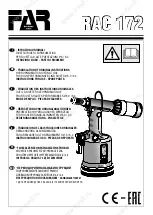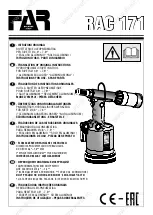
6
GB
Introduction
Thank you for purchasing this Triton product. This manual contains information
necessary for safe and effective operation of this product. This product has unique
features and, even if you are familiar with similar products, it is necessary to read this
manual carefully to ensure you fully understand the instructions. Ensure all users of
the product read and fully understand this manual.
Product Familiarisation
1. Drill Guides
2. Guide Block
3. Clamp
4. Micro Adjuster
5. Lever Handle
6. Countersunk Bench Mount Hole
7. Side Scale
8. Base Plate
9. Locking Knob
10. Thickness Guide
11. Magnetic Dust Extraction Adaptor
12. Depth Collar
13. Step Drill Bit
14. Driver Bit
15. Screw
16. Plug
17. Hex Key
Intended Use
Pocket-hole jig for repeated use in joinery work. Can be used for panel fixing, corners
and mitre joints.
Before Use
WARNING
: Always adhere to all safety advice and instructions for any power tool
used in conjunction with this product.
Mounting
• It is recommended that this jig be mounted to a bench before use
• The jig can be clamped to a bench, or it can be fixed using suitable screws through
the Countersunk Bench Mount Holes (6)
• The jig can also be fixed to a portable mounting board that would be clamped to a
suitable workbench, which makes the jig portable and secure
Dust extraction
• The Magnetic Dust Extraction Adaptor (11) clips on to the magnets on the Guide
Block (2) (Fig. I)
• A suitable dust extraction system or vacuum can be attached
• Turn ON the dust extractor/vacuum prior to drilling
Operation
WARNING
: NEVER hold the jig by hand when drilling; it must be fixed securely
to a suitable workbench. Failure to do so could damage the tool and/or cause serious
personal injury.
Note
: Generally, set the jig then set the drill depth. Ideally, the drill tip should emerge
close to the middle of the material being drilled.
1. Determine the thickness of the material to be drilled by measuring with a tape
measure (Fig. II) or the 0 – 50mm Side Scale (7)
2. Slide the Guide Block (2) up to match the thickness of the material being drilled
using the Thickness Guide (10), then lock in place using the Locking Knobs (9) (Fig.
III)
3. Place the Depth Collar (12) on the Step Drill Bit (13) (Fig. IV) and insert into the Drill
Guide (1)
4. When the end of the bit is 2 – 3mm from the Base Plate (8) (Fig. V) tighten the
Depth Collar using the Hex Key (17) but do not overtighten, then remove the bit
from the Drill Guide
5. Insert the workpiece squarely against the Guide Block and Base Plate and push the
Lever Handle (5) forward to clamp the workpiece (Fig. VI). If there is not enough or
too much pressure, pull the Lever Handle back and adjust the Clamp (3) and Micro
Adjuster (4) by turning them on the thread (Fig. VII), then push the Lever Handle
forward to try to clamp the workpiece again
6. Insert the Step Drill Bit into the power drill and set the drill to high speed
7. Insert the end of the Step Drill Bit into one of the Drill Guides and start the drill
Note
: If the Magnetic Dust Extraction Adaptor (11) and a suitable dust extraction
system or vacuum are connected, turn this ON prior to drilling.
8. Drill using a stage cutting action for chip and dust clearance until the Depth Collar
is flush against the Drill Guide then stop drilling and remove from the drill guide
(Fig. VIII)
9. Release the Clamp and remove the workpiece with the drilled pocket-hole joint (Fig.
IX). The piece is ready for the pocket-hole screws and plugs. See the table below
for recommended screw size
Timber Thickness
Screw
13 – 18mm / ½" –
11
⁄
16
"
25mm / 1"
19 – 25mm / ¾" – 1"
30mm / 1
1
⁄
4
"
26 – 30mm / 1" – 1
1
⁄
4
"
35mm / 1
1
⁄
2
"
31 – 37mm / 1
1
⁄
4
" – 1
7
⁄
16
"
50mm / 2"
≥38mm / ≥1
1
⁄
2
"
60mm / 2
1
⁄
2
"
Note
: For hard wood use a fine thread, and for soft wood use a coarse thread.
Tips
• When assembling a joint, use a backing board (Fig. X)
• The pocket-hole jig can be used for framing and mitre joints (Fig. XI)
• The pocket-hole jig can be used for joining panels (Fig. XII)
Accessories
• A full range of accessories including jigs, plugs, screws and bits is available from
your Triton stockist
Maintenance
Contact
For technical or repair service advice, please contact the helpline on (+44) 1935
382 222
Web: tritontools.com/en-GB/Support
Address:
Powerbox
Boundary Way
Lufton Trading Estate
Yeovil, Somerset
BA22 8HZ, United Kingdom
Original Instructions
355399_Manual.indd 6
10/01/2018 14:13
Summary of Contents for Pocket-Hole Jig 7pce
Page 2: ...2 355399_Manual indd 2 10 01 2018 14 13 ...
Page 3: ...3 1 14 17 12 13 15 16 2 3 4 6 7 8 9 10 11 5 355399_Manual indd 3 10 01 2018 14 13 ...
Page 4: ...4 GB Fig VI Fig IV Fig II Fig V Fig VII Fig III Fig I 355399_Manual indd 4 10 01 2018 14 13 ...
Page 5: ...5 GB Fig VIII Fig IX Fig XI Fig XII Fig X 355399_Manual indd 5 10 01 2018 14 13 ...
Page 19: ...19 Notes 355399_Manual indd 19 10 01 2018 14 13 ...






































